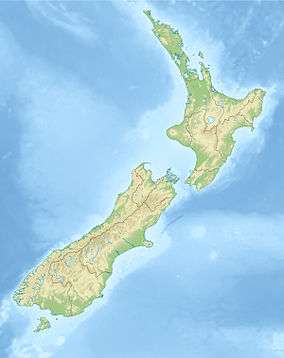Lake Harihari
| Lake Harihari | |
|---|---|
 Lake Harihari Lake Harihari is in the Waikato Region of the North Island | |
| Location | Waitomo District, Waikato Region, North Island |
| Coordinates | 38°12′35″S 174°43′23″E / 38.20972°S 174.72306°E |
| Lake type | oligomesotrophic lake |
| Primary outflows | seepage |
| Catchment area | 134 ha (330 acres) |
| Basin countries | New Zealand |
| Surface area | 18.39 ha (45.4 acres) |
| Max. depth | 9 m (30 ft) |
| Surface elevation | 20 m (66 ft) |
Lake Harihari is a dune-dammed lake 10 km south of Kawhia in the Waikato region of New Zealand. Its water quality is the best among the Waikato dune lakes. It is ranked eighth in importance in the region.
Geology
The lake is dammed by the dunes, though in wet weather a stream flows from it.[1] Under the dunes a hard strong friable greywacke sandstone forms most of the coastline from Albatross Point to Awakino.[2] It is part of the Late Triassic (Oretian-Otapirian) rocks of the Newcastle Group.[3]
The lake bed belongs to Taharoa Lakes Trust and the land around it is private. Waikato Biodiversity Forum said, "We know of only one other shallow lake in the region that is comparable in terms of water quality." It is ranked eighth in regional importance as a Category Two Lake – high condition, high vulnerability.[4]
Biota
Lake Harihari has the best quality of all the Waikato dune lakes[5] with oligomesotrophic water quality.[1] Works such as a trial fish passage structure (installed in 2009), fencing a 37 to 80m buffer (started in 2005),[6] and over 6,000[7] new plants, selected to withstand the harsh coastal winds and dry summers,[8] aim to improve the lake's value.[1] Biota recorded include dabchicks,[1] shells, a large freshwater mussel population,[1] freshwater sponges (common), native snails,[1] native fish, the common bully and New Zealand smelt.[1]
The health of the lake is indicated by the variety of zooplankton in it - rotifers (Anuraeopsis fissa, Synchaeta grandis, S. longipes, Ascomorpha ovalis, Brachionus angularis, B. caliciflorus, Keratella cochlearis, K. tecta, Polyarthra dolichoptera, Trichocerca similis), Bosmina meridionalis, Calamoecia lucasi, Mesocyclops leuckarti, nauplii.[9] However, there are also weed species such as willow, pampas, kikuyu[1] and Canadian pondweed.[5]
History
The archaeology map shows a dozen sites around and near the lake.[10]
See also
References
- 1 2 3 4 5 6 7 8 "Waikato Region – Lake Ecosystems 2011 report" (PDF). Waikato Regional Council. p. 107.
- ↑ "West Coast Hazard Project: Environment Waikato 2008" (PDF). Retrieved 2013-10-26.
- ↑ Geology of the Waikato Area: IGNS 2005 page 21
- ↑ Waikato Regional Policy Statement (November 2010)
- 1 2 "The condition of lakes in the Waikato Region using SPI" (PDF). Waikato Regional Council.
- ↑ "2013 WRC update with map and photos" (PDF). Retrieved 2013-10-26.
- ↑ "Regional Pest Management Committee Aug 2013 with before and after photos" (PDF). Retrieved 2013-10-26.
- ↑ "Waikato BioForum Newsletter August 2011 Number 32". Waikato Biodiversity Forum.
- ↑ "An Assessment of the Water Quality of Ten Waikato Lakes Based on Zooplankton Community Composition 2007" (PDF). Retrieved 2013-10-26.
- ↑ "archaeology map". Nzaa.eaglegis.co.nz. Retrieved 2013-10-26.